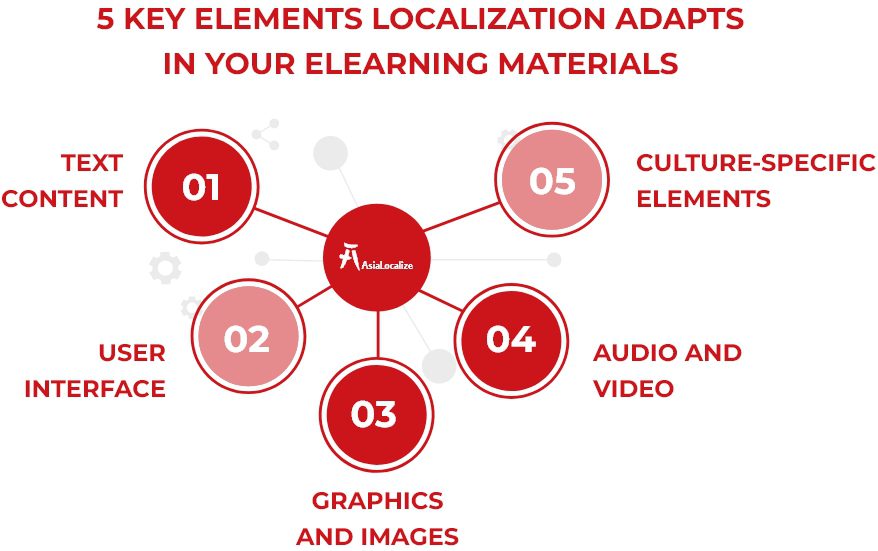
The rise of eLearning has transformed the way we approach education and training. However, despite it brought about ultimate convenience and accessibility, language barriers still stand between multilingual learners and their quest for knowledge.
The story doesn’t stop there, though.
If you are operating in the eLearning industry or using online courses to train your multinational workforce, you can surely relate to the struggle of maximizing the value of your content while language barriers hinder your outreach and ability to cater to the diverse needs of your employees.
The demand for eLearning localization as a solution for bridging these gaps is really clear. But the process itself is often mistakenly perceived as too complex or daunting to undertake, holding many organizations back from realizing its full impact on their international success.
In this blog, we will break down the eLearning localization process into manageable and show you how embracing localization can yield amazing benefits for your business.
What is eLearning localization?
eLearning localization is the process of adapting your online courses, multimedia presentations, or eLearning platform to resonate with the cultural expectations and preferences of your intended learners, resulting in a personalized, engaging experience that teaches in a locally relevant way.
This intricate process encompasses various aspects, including translating the course content into the desired language, adapting graphics and multimedia to suit the local culture, and making necessary modifications to ensure seamless, interactive learning for all learners.
Here are key elements that are adapted along the process of eLearning localization:
- Text Content
- User Interface
- Graphics and Images
- Audio & Video
- Culture-Specific Elements


Why You Shouldn’t Just Translate Your eLearning Materials
You’ve probably heard it everywhere: creating effective multilingual eLearning materials requires more than just translation. But why? Let’s break it down for you.
Translation can be a great option to get your eLearning courses ready for global audiences or a diverse workforce, but this applies only to technical, culture-neutral content like practical employee training or skill building.
When it comes to eLearning materials that cover culturally-bound topics, adopting a translation-only approach is never adequate. Simply translating text word-for-word can result in content that doesn’t make sense or resonate in other cultures.
A course on business negotiation strategies or office etiquette, for instance, would need to be adapted to resonate with learners from different cultures. The content, examples, and best practices would vary based on the target country and language, and simply translating them would not be sufficient.
– One final thing to highlight is that the choice between localization and translation is not solely dependent on content type. Localization differs significantly in its comprehensive, culturally intelligent approach to adapting eLearning content
Find more about the eLearning localization process below!



Why eLearning Localization Matters? Amazing eye-opening stats you need to check instantly!
eLearning Localization: A Closer Look At The Process
From the initial research and analysis stages to final delivery, the localization process requires linguistic and cultural expertise and utmost care and attention to detail at each step.
Allow us now to guide you through the multiple stages of eLearning localization to show you how language professionals analyze, adapt, and refine your educational and training materials to resonate with learners and trainees everywhere.
The 5 Essential Stages of eLearning Localization
1- Evaluation and Analysis
This is the first and the most important stage of localizing eLearning content. We say most important because typically it is the one that determines priorities and informs all the stages that follow.
At this stage, two equally important aspects are thoroughly analyzed and evaluated:
Course Content
All course components, from written elements and visual assets to interactions, assessments, and metadata taxonomy undergo meticulous audits to identify any aspects tied to culture-specific contexts and determine localization needs.
Target Audiences
A team of experts conducts culturally sensitive research to study the target learner groups, their cultural preferences, language nuances, and how they typically consume online learning content, which all may vary based on many factors:
- Age and preferences between younger/older demographics
- Gender and engagement with certain subjects/styles
- Culture and resonance with varied content/formats
- Socioeconomics and access issues that impact optimization
2- Preparation
Based on the evaluation and analysis, this phase sets the content up for a coherent, systematic translation and integration workflow by bundling all elements into a consistent, convenient format for linguists to work on. During the preparation stage:
- All textual elements identified for translation during the evaluation (e.g. written text, audio scripts, captions) are extracted from source files into a format suitable for translating, like Excel or XML files to streamline the process.
- Any embedded text in images, videos, or slides is extracted so it too can be translated. Alternative text is added to ensure accessibility and SEO for translations. For right-to-left languages, formatting plans are made to accommodate their text direction.
- A standardized template or structure is applied to all extracted content files to maintain formatting consistency through localization. This facilitates easy navigation and the seamless integration of translations back into the files.
3- Translation & Localization
This is the main part of the eLearning localization process where the actual translation and localization are done. Translation is used for text content, while localization involves adapting all aspects of eLearning materials to meet the cultural, linguistic, and other specific requirements of the target learners.
During the process, a multidisciplinary team of translators, localization experts, and desktop publishing specialists does the following:
- Translate all written content like quizzes, assessments, and any textual elements in the materials while maintaining the intended meaning and instructional effectiveness.
- Localize audio/video content using the best approach that meets the preferences of the intended users, either by re-recording voiceovers in the target language (dubbing), translating closed captions, etc.
- Adapt illustrations, images, diagrams, and animations to appeal to the target learners, which might involve modifying or creating new visual elements. Also, alternative text is translated at this point.
- Tackle any changes that need to be made to your eLearning platform’s user interface (UI):
- The overall interface structure and navigation flow
- Layouts, spacing, and visual hierarchies
- Font properties, date/time formats, numbers, currencies
- The placement of navigational menus and controls
- Responsive design capabilities to suit all device types and screen sizes.
4- Editing & Proofreading
Once the content is translated, it undergoes a rigorous editing and proofreading process. Native speakers with subject matter expertise meticulously review the localized materials.
The QA team ensures the content meets the linguistic and cultural expectations of the target audience. They identify any issues related to grammar, syntax, vocabulary, or stylistic consistency with the original version.
A critical aspect of this quality-checking process is culturally validating the content by checking that cultural references and examples were appropriately localized for the context and looking for potentially sensitive topics, taboo terms, or other content that requires further refinement.
5- Localization Testing
Usability Testing
Usability testing checks for factors such as ease of navigation, clarity of instructions, appropriateness of visuals and terminology used, and overall user experience. Accordingly, there could include changes to the user interface, content modifications, or instructional design adjustments.
Accessibility Testing
While localization helps bridge language barriers, allowing learners of any background to access content, it is equally important to consider learners with disabilities. Nothing should ever stop your target learners from accessing your content, and that’s why accessibility testing should be an integral part of the localization testing process to confirm localized content remains inclusive by verifying:
- Alternative text accommodates screen reader users
- Color contrasts permit visibility for low vision
- Structured headings/titles aid navigation
- Keyboard shortcuts allow full functionality
- Audio/visual media include descriptions and transcripts
Functionality & Compatability Testing
This testing process identifies any technical issues or bugs that may impact the user experience or prevent the content from functioning as intended. It can include testing the courseware’s interactive elements, such as quizzes, simulations, and interactive videos.
It also makes sure that the localized content works seamlessly on all the platforms and devices where it will be accessed, for example, testing its compatibility with various web browsers, operating systems, and devices.



A Cost Or Opportunity: Is eLearning Localization Worth Your Money?
At first glance, eLearning localization services may seem like an added cost. Yet, taking a broader view beyond the upfront investment it requires, you will find that the value it can generate far outweighs the initial cost.
For any company operating globally, whether in education technology or another sector requiring worldwide workforce training, localizing courses and training materials opens the door to significant ROI opportunities. Let’s have a closer look at the long-term benefits it offers.
Growing Your Audience Base
You’ve perfected engaging eLearning content, but are you maximizing your full international potential? Limiting language support restricts your ability to connect with learners globally.
Some of the largest online student populations hail from India, Mexico, Brazil, China, Russia, Colombia, and Egypt – diverse regions speaking many languages besides English. Without a proper localization strategy for your eLearning content, you miss opportunities within these fast-growing markets.
Localized eLearning customized for target audiences in their preferred language broadens your reach and immersion. It empowers confidently tapping into thriving regions where captivating, resonant material motivates ongoing engagement with your platform.
Fostering An Inclusive And Engaging Workplace
If you have a multilingual workforce to train in your organization, you can’t imagine how helpful providing training in their language can be for the success of your organization.
This strategic move enhances your employees’ sense of inclusion, fostering their loyalty and engagement as they feel their career development is prioritized.
And in an environment where everyone feels valued and becomes more actively engaged, the result is always better performance, higher productivity, and less staff turnover.
Research shows that organizations that see higher engagement rates from their employees are 21% more profitable. Remember, your employees’ collective success is the driving force behind your organization’s success.


Saving Money And Time & Maximizing Staff Efficiency
Tailoring online training content to your employees’ language can dramatically boost their understanding and retention of information, resulting in both notable cost savings and improved staff performance.
When training is easily understood from the beginning, the time needed to train and upskill your employees is reduced, as is the necessity for additional training. moreover, you will also save costs associated with on-the-job issues resulting from lacking essential knowledge.
Non-English speaking workers in the US often face difficulties in fully grasping the content of English-only training, lacking the language skills necessary to engage with the material fully and ask pertinent questions. This gap in comprehension can lead to a disappointing return on the initial training investment.
Therefore, while there may be some initial costs to localize training materials, the long-term savings, along with the increased efficiency of your workforce, can lead to a much higher return on investment. This approach is far more cost-effective than facing the substantial hidden costs associated with high staff turnover, which can sometimes exceed 200% of an employee’s annual salary.
Have an eLearning Localization project on the horizon? AsiaLocalize offers you a gateway to a team of professionals who are not only native speakers of your target language but also possess the specialized knowledge and technological tools required to provide top-quality localization solutions.



Our reliable services help you optimize the impact of your training investments worldwide

